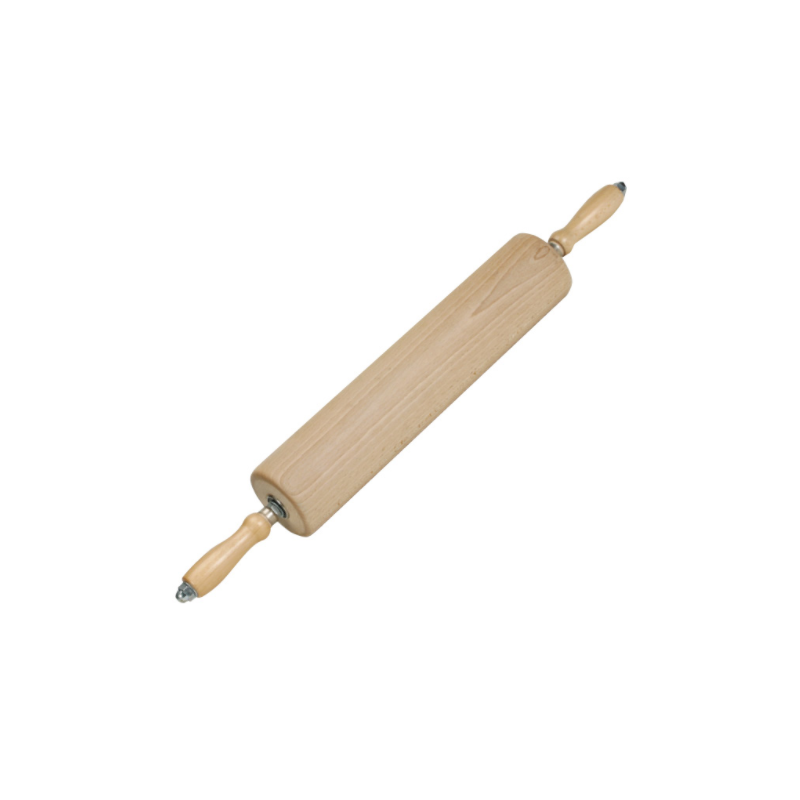



A rolling pin is always a good helper in the kitchen, whether it's for Christmas cookies, a tart base, a honey dough or the thin base of a pizza. The rolling pin prevents the strong sticking of these masses and thus ensures, with a little additional flour or baker's starch on doughs as well as decorative masses for a smooth surface. The total length is 68 cm, of which 40 cm are rolling surface.
Data sheet
A rolling pin is always a good helper in the kitchen, whether it's for Christmas cookies, a tart base, a honey dough or the thin base of a pizza. The rolling pin prevents the strong sticking of these masses and thus ensures, with a little additional flour or baker's starch on doughs as well as decorative masses for a smooth surface. The total length is 68 cm, of which 40 cm are rolling surface.
Professional rolling pin - application
First, of course, you need to prepare your dough. Make, for example, your favorite Guetzli dough or a shortcrust pastry for a tart. Pizza dough, tarte flambée dough or foccacia dough are also no problem and can be easily made in your own kitchen. These should first be left to rise according to the recipe, cookie dough and tart bases are easiest to work with after a night in the refrigerator. Fondant or other decorating masses are well pre-kneaded, then you work with enough baker's starch.
Then sprinkle some flour on your clean work surface. For a brunslite dough, use sugar for this, but for many doughs you can also dust some baker's starch. Gently flatten the prepared dough and place it in the center of your work surface. Also put some flour on the surface and rub the rolling pin (the dough roller) a little bit with it. This way you will get the best results afterwards.
Now you can roll with the rolling pin (dough roller) again and again from the center to the outside. For a round shape, you can turn the dough a little in between and thus roll in all directions, for a rectangle you only roll in two directions. Depending on the stickiness of the dough, you should always add a little dusting and, with the help of the rolling pin, lift everything up from time to time. In this way, you will notice early on if the dough sticks to the surface and you can also sprinkle flour underneath. Some doughs always pull together a little. Stay patient, let the dough rest very briefly and roll out again a little more. If you pull on the dough, it may tear.
This also applies to lifting up the finished rolled out form. Do not simply grab it by the edge and lift it up, otherwise it will warp or even crack. Instead, place the rolling pin (the dough roller) on one side of the dough and fold the other half over it. This way you can easily lift the dough and place it on a baking sheet or in a tart pan.
Rolled out nice and thin, the dough can now be topped, cut out, or carefully pressed into the tart, quiche, or roll pan. Thanks to the smooth surface of the rolling pin, the dough remains nice and smooth and does not stick together. The wooden rolling pin is best cleaned by hand with a damp cloth or under running water if it sticks together. Make sure that the stick is not soaked for a long time and has enough time to dry after cleaning.
 Linzertorte
Linzertorte
 Heart Cake with Vanilla and Raspberry
Heart Cake with Vanilla and Raspberry
 Grill bread recipe
Grill bread recipe
 Apple and almond cake recipe
Apple and almond cake recipe
 Berry tart for Valentine's Day
Berry tart for Valentine's Day

A rolling pin is always a good helper in the kitchen, whether it's for Christmas cookies, a tart base, a honey dough or the thin base of a pizza. The rolling pin prevents the strong sticking of these masses and thus ensures, with a little additional flour or baker's starch on doughs as well as decorative masses for a smooth surface. The total length is 68 cm, of which 40 cm are rolling surface.